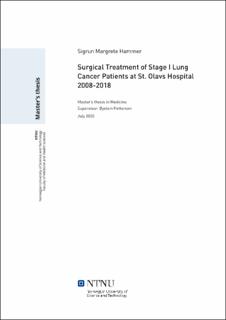| dc.contributor.advisor | Pettersen, Øystein | |
| dc.contributor.advisor | Haram, Per Magnus | |
| dc.contributor.author | Hammer, Sigrun Margrete | |
| dc.date.accessioned | 2021-09-13T16:16:06Z | |
| dc.date.available | 2021-09-13T16:16:06Z | |
| dc.date.issued | 2020 | |
| dc.identifier | no.ntnu:inspera:60686860:15937089 | |
| dc.identifier.uri | https://hdl.handle.net/11250/2775939 | |
| dc.description.abstract | Sammendrag
Bakgrunn:
Lungekreft er på andreplass over de mest vanlige krefttypene, og den typen kreft som står for høyest andel kreftrelaterte dødsfall i Norge. Lungekreft er del inn i fire stadier basert på TNM-systemet. Stadium I pasienter har best prognose og er tradisjonelt sett behandlet kirurgisk med kurativ hensikt. Nye tilnærminger når det gjelder behandlingsmetoder og diagnostikk har blitt mer tilgjengelig de siste årene, og overlevelsen for stadium I lungekreftpasienter har vist lovende trender siste tiår.
Pasienter og metoder: Målet med denne studien var å gjøre en kvalitetssikring av alle stadium I NSCLC pasienter som ble kirurgisk behandlet på St. Olavs Hospital i Trondheim fra 01.01.2008 – 31.12.2018 (n=587). Fokus har vært på overlevelse etter kirurgi og å identifisere variabler og deres rolle i pasientoverlevelse, samt å bruke deskriptiv statistikk for å se nærmere på forandringer i pasientkarakteristikk, behandling og diagnostikk.
Resultater: Denne studien viser en 30 og 90-dager, 1, 3 og 5-års overlevelse på henholdsvis 99,5%, 98,3%, 94, 6%, 84,8% og 75,1%. For pasienter med N0 vs N1/N2-sykdom var det en 5-års overlevelsesforskjell på 76,4%(N0) vs 57,1% (N1/2). 12% av alle pasientene hadde et pTNM stadium >I, dette inkluderer 7,8% med positiv N1/N2 og 4,2% av pasientene som hadde et T-stadium som oversteg kriteriene for stadium I.
Endringer i diagnostikk og behandling ble også oppdaget. Bruken av PET CT har økt fra å være brukt i 27% tilfeller i 2008, til å bli brukt i mer enn 80% av tilfellene siden 2013. Det har også vært en endring i bruken av minimalt invasive teknikker. I 2008 ble 100% av pasientene behandlet med thorakotomi. I 2018 ble over 80% behandlet med thorakoskopi. Parallelt med disse forandringene økte også mengden høstede N2-knuter. I 2008 hadde 27% av pasientene null høstede N2-lymfeknuter. I 2018 hadde kun 6,4% av pasientene null høstede N2-knuter, hvorav nesten 80% hadde to eller flere høstede N2-knuter.
Konklusjon: Overlevelsesraten hos kirurgisk behandlede pasienter matcher nasjonale og internasjonale tall i forhold til overlevelse, og diagnostikk og behandling på St. Olavs er i tråd med nasjonale retningslinjer. Det har vært endringer i diagnostikk og kirurgiske prosedyrer ved St. Olavs hospital fra 2008-2018 hvilket har vist at mindre invasive teknikker fortsatt fører til økt lymfeknutehøsting. | |
| dc.description.abstract | 1. Abstract
Background: Lung cancer is in Norway the second most prevalent cancer type, and responsible for the highest number of cancer related deaths in Norway. Lung cancer is divided into four stages based on the TNM system. Patients with Stage I has the best prognosis and is traditionally treated with surgical removal of the tumour with the intention to cure. Improved treatment methods and diagnostics have become more available during the last years and the survival for stadium I lung cancer patients has shown promising trends during the last decades.
Patients and Methods: The aim of the study was to do a quality assurance of patients surgically treated at St. Olav’s Hospital in Trondheim from 01.01.2008 – 31.12.2018 (n=587). Only patients preoperatively determined to be Stage I Non-Small Cell Lung Cancer were included. The focus has been on survival after surgery and identifying variables and their role in patient survival, as well as using descriptive statistics to survey changes in patient characteristics, treatment and diagnostics.
Results: The study shows a 30, and 90 – days, 1,3 – and 5-year survival of 99,5%, 98,3%, 94, 6%, 84,8% and 75,1% respectively. For the patients with N0 vs N1/2 disease, there was a 5-year survival difference of 76,4 %(N0) vs 57,1% (N1/2). 12% of all the patients had a pTNM stage >I, this includes 7,8% with positive N1/N2, and 4,2% patients who had a T stadium which exceeded the criteria for stage I.
A trend of change in diagnostics and treatment was discovered. The increase in use of PET CT has changed from 27% in 2008 to be used in more than 80% of all cases from 2013. There has also been a change in the use of minimally invasive techniques, in 2008, 100% of the patients were assigned for thoracotomy. In 2018 more than 80% were assigned for thoracoscopy. Parallel to these changes the amount of harvested lymph nodes has also increased. In 2008, 27% patients had zero harvested N2-lymph nodes. In 2018 only 6,4 % of the patients had zero harvested N2 lymph nodes, whereas almost 80% had two or more harvested N2 lymph nodes.
Conclusion: The survival of surgically treated lung patients matches national and international numbers, and both diagnostics and treatment is performed according to national guidelines. There has been changes in diagnostics and surgical procedures at St. Olav’s hospital from 2008 – 2018 which has shown that less invasive surgery still seems to provide increased amount of harvested N2- stations. | |
| dc.language | | |
| dc.publisher | NTNU | |
| dc.title | Surgical Treatment of Stage I Lung Cancer Patients at St. Olavs Hospital 2008-2018 | |
| dc.type | Master thesis | |
